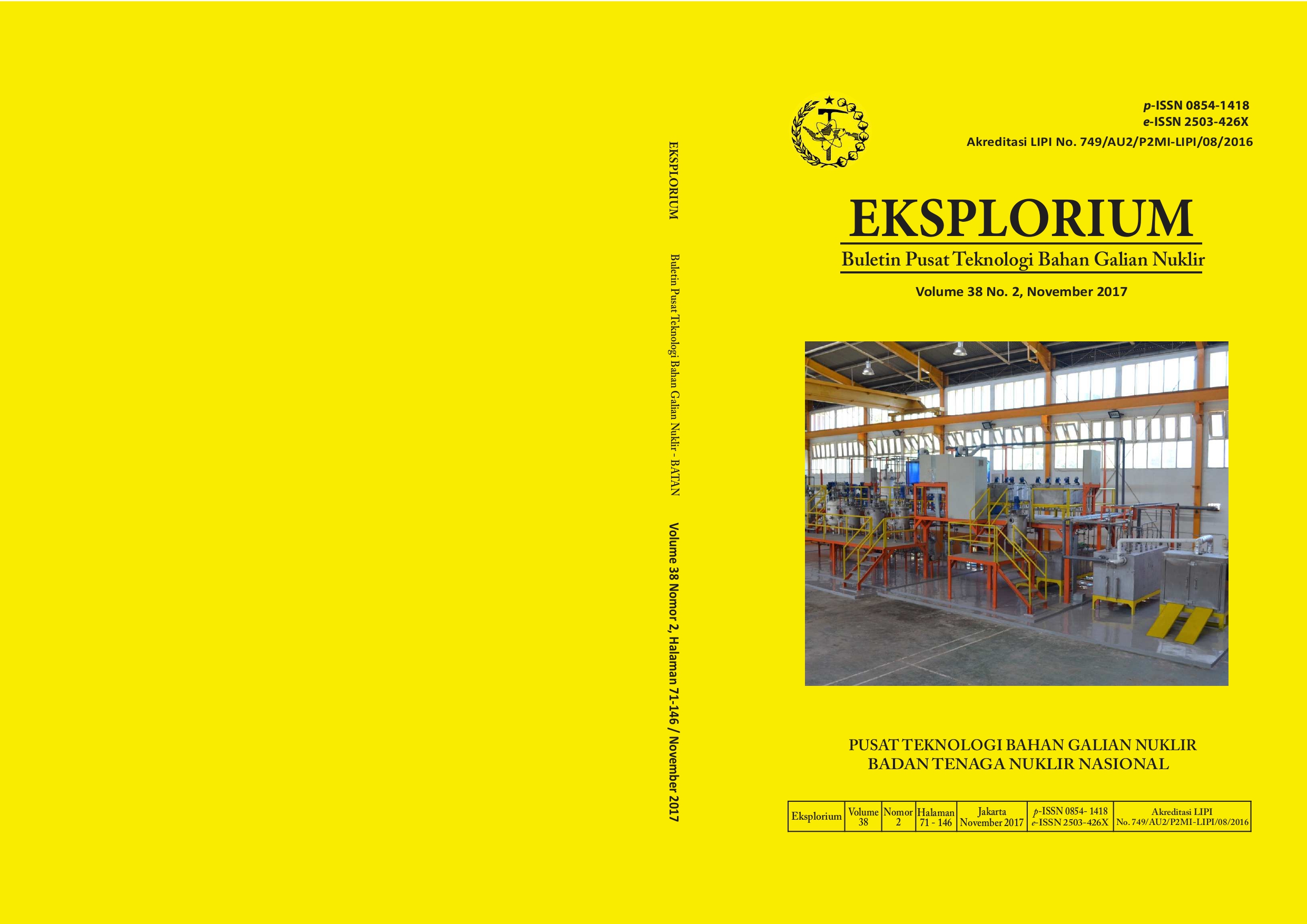Studi Ekstraksi Bijih Thorit dengan Metode Digesti Asam dan Pemisahan Thorium dari Logam Tanah Jarang dengan Metode Oksidasi-Presipitasi Selektif
Main Article Content
Abstract
Article Details

This work is licensed under a Creative Commons Attribution-ShareAlike 4.0 International License.
1. Introduction
By using or sharing content from EKSPLORIUM - Buletin Pusat Pengembangan Bahan Galian Nuklir ("the Journal"), you agree to follow these Terms and Conditions. The Journal's content is licensed under the Creative Commons Attribution-NonCommercial-ShareAlike (CC BY-NC-SA) license. If you do not agree to these terms, please do not use the content.
2. How You Can Use the Content
-
Share: You can copy, share, and distribute the work, but only for non-commercial purposes.
-
Adapt: You can change, remix, or build on the work, as long as it is for non-commercial purposes and you share it under the same license (CC BY-NC-SA).
3. Attribution (Giving Credit)
When you use or share the content, you must:
-
Give proper credit to the author(s).
-
Mention the title of the work and the journal name.
-
Provide a link to the license (https://creativecommons.org/licenses/by-nc-sa/4.0/).
-
Indicate if you made any changes to the work.
4. Non-Commercial Use
You cannot use the work to make money or for any commercial activities. For example, you cannot sell or use the content in advertisements.
If you want to use the content for commercial purposes, you need to get permission from the author(s) or the publisher.
5. ShareAlike
If you make changes to the content (like creating a new version or remixing it), you must share your new version under the same CC BY-NC-SA license.
6. Exclusions
Some materials in the Journal may have different licenses or restrictions, such as third-party content (like images or datasets). You must respect the rules for those materials.
7. No Warranty
The content is provided "as is." The authors and publisher do not guarantee that the content is error-free or suitable for any specific purpose. Use the content at your own risk.
8. Modifications and Withdrawal of Content
The publisher and authors can update or remove content at any time. If content is removed, the previous versions will still follow these terms.
9. Ethical Use
You must use the content ethically and follow all relevant laws. This includes properly citing the original authors and not misusing the content.
10. Legal Compliance
You are responsible for making sure your use of the content follows the laws of your country. If you believe content violates your rights, please contact us.
11. Changes to Terms
These Terms and Conditions may be updated from time to time. Any changes will be posted on the Journal's website.
12. Contact Information
For questions about these Terms or for permission to use content commercially, please contact us at:
-
Email: eksplorium@brin.go.id
-
Website: https://ejournal.brin.go.id/eksplorium
Conclusion
By using the content from EKSPLORIUM - Buletin Pusat Pengembangan Bahan Galian Nuklir, you agree to follow these Terms and Conditions and the CC BY-NC-SA 4.0 International License.
References
[1] BP, “BP Energy Outlook Energy 2017,” BP Stat. Rev. World Energy, p. 52, 2017.
[2] Secretary General of National Energy Council, “Indonesia Energy Outlook 2016,” pp. 1–129, 2016.
[3] R. Indonesia, “Perpres 22 Tahun 2017.pdf.” 2017.
[4] E. Dewita, “Analisis Potensi Thorium Sebagai Bahan Bakar Nuklir Alternatif PLTN,” J. Pengemb. Energi Nukl., vol. 14, no. Juni 2012, pp. 45–56, 2012.
[5] T. Burke, “The Characterization of Commercial Thorium Oxide Powders,” in Bettis Atomic Power Laboratory Report WAPD-TM-1508, 1982.
[6] K. Trinopiawan, M. Z. Mubarok, J. Mellawati, and B. Y. Ani, “Rare Earth Elements Leaching From Tin Slag Using Acid Chloride After Alkaline Fusion Process,” Eksplorium, vol. 37, no. 1, pp. 41–50, 2016.
[7] N. Krishnamurthy and C. K. Gupta, Extractive Metallurgy of Rare Earths, Second Edi. 2016.
[8] Suyanti and Suprihati, “Pemurnian torium dengan memakai tributil fosfat,” 2010.
[9] K. G. Shaw, “A process for separating thorium compounds from monazite sands,” Chem. Eng., 1953.
[10] M. Benedict, Nuclear Chemichal Engineering, 2nd Editio. McGraw-Hill Book Company, 1981.
[11] Z. Talip, M. Eral, and U. Hiçsonmez, “Adsorption of thorium from aqueous solutions by perlite,” J. Environ. Radioact., vol. 100, pp. 139–143, 2009.
[12] R. Prasad and A. K. Dey, Studies of Precipitation of Thorium Hydroxide. Springer-Verlag, 1961.
[13] M. Z. Mubarok and A. Dilova, “Atmospheric Leaching Behaviorof East Java Chalcopyrite Ore in Sulfuric Acid Solution and Hydrogen Peroxide as Oxidizing Agent,” in Proceedings of International Symposium on Earth Science and Technology, 2013.
[14] H. Li, The Solubilities of Oxygen in Sulphuric Acid Solutions Containing and/or Nickel Sulphate at Atmospheric and High Pressures. Canada: University of Ottawa, 1994.
[15] R. A. Hasty and J. E. Boggs, “Formation and Properties,” J. Less Common Met., vol. 13, no. 16, pp. 218–222, 1974.
[16] L. Pissarjewski, “Die Superoxyde des Zirkoniums, Ceriums und Thoriums,” J. Inorg. Gen. Chem., vol. Vol. 25, no. No 2, pp. 378–398, 1900.
[17] R. D. Abreu and C. A. Morais, “Purification of rare earth elements from monazite sulphuric acid leach liquor and the production of high-purity ceric oxide,” Miner. Eng., vol. 23, no. 6, pp. 536–540, 2010.
[18] P. Yu, S. A. Hayes, T. J. O’Keefe, M. J. O’Keefe, and J. O. Stoffer, “The Phase Stability of Cerium Species in Aqueous Systems: II. The Ce (III/IV)-H2O-H2O2O2 Systems. Equilibrium Considerations and Pourbaix Diagram Calculations,” J. Electrochem. Soc., vol. 153, no. 1, pp. C74–C79, 2006.

